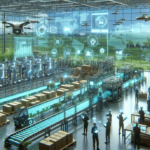The Evolution of Innovation: Historical and Modern Drivers
Necessity has been a fundamental driving force behind innovation for centuries. From the earliest human advancements to contemporary technological breakthroughs, the need to overcome challenges has spurred progress.
Necessity in Ancient Innovations
Throughout history, human ingenuity has been propelled by basic survival needs. For instance, the invention of the wheel around 3500 BC in Mesopotamia was a direct response to the necessity of transporting heavy objects more efficiently. This breakthrough not only revolutionized transportation but also facilitated the development of trade and cultural exchange.
Another example is the development of agriculture. As humans transitioned from nomadic lifestyles to settled farming communities, the need to cultivate crops and manage water resources led to the invention of irrigation systems, plows, and storage facilities, laying the foundation for modern civilization.
Modern Challenges Driving Innovation
In the modern era, the nature of challenges has evolved, yet necessity remains a key motivator for innovation. Contemporary issues such as climate change, cybersecurity threats, and global health crises demand innovative solutions to sustain and improve societal well-being.
For example, the urgent need to address climate change has accelerated the development of renewable energy technologies like solar and wind power. According to the International Renewable Energy Agency (IRENA), renewable energy accounted for nearly 29% of global power generation in 2020, demonstrating the significant impact of necessity on energy innovation.
The Psychology of Necessity: Stimulating Creativity and Problem-Solving
Necessity not only propels societal advancements but also has a profound psychological impact on individuals, fostering creativity and enhancing problem-solving capabilities.
Urgency and Creative Thinking
When individuals face urgent needs, their cognitive processes are streamlined towards finding effective solutions. Research indicates that urgency activates the brain's frontal lobe, enhancing executive functions that are critical for creative thinking and decision-making (source).
Motivation and Sense of Purpose
Furthermore, the psychological impetus of necessity cultivates a strong sense of motivation and purpose. People driven by necessity often experience heightened determination and resilience, attributes that are essential for overcoming complex challenges and achieving innovative outcomes.
Additionally, necessity can lead to the discovery of new skills and talents, contributing to personal growth and fulfillment. This intersection of need and creativity underscores the intrinsic relationship between psychological states and innovative potential.
Scarcity and Constraints: Catalysts for Breakthroughs
Scarcity and limitations have historically served as catalysts for innovation, compelling individuals and societies to devise creative solutions to resource shortages.
Historical Examples of Scarcity-Driven Innovation
During World War II, resource scarcity led to significant technological advancements. The shortage of natural rubber spurred the development of synthetic alternatives, such as neoprene, which became essential for manufacturing various military and civilian products (Encyclopedia Britannica).
Similarly, the scarcity of fuel during the energy crises of the 1970s accelerated research into fuel-efficient vehicles and alternative energy sources, laying the groundwork for today’s hybrid and electric vehicles.
Modern Sustainability and Resource Efficiency
In contemporary times, scarcity drives innovation towards sustainability and resource efficiency. Limitations in natural resources necessitate the development of technologies that optimize usage and reduce waste.
For instance, water scarcity in arid regions has led to innovative irrigation technologies, such as drip irrigation systems, which significantly reduce water consumption while maintaining agricultural productivity (FAO).
Real-World Examples of Necessity-Driven Innovations
Many of the world’s most impactful inventions have emerged from pressing needs and challenges, exemplifying how necessity drives innovation.
Communication Technologies
The invention of the telephone by Alexander Graham Bell in 1876 was motivated by the need to communicate more effectively over long distances, especially to connect with his hearing-impaired wife (Encyclopedia Britannica).
Healthcare Advances
The development of the pacemaker in the 1950s by John Hopps stemmed from the critical need to regulate heartbeats in patients undergoing surgery (FDA).
Environmental Technologies
The rise of microplastics pollution led to innovations in biodegradable materials, aiming to mitigate environmental impact and promote ecological sustainability.
The Future of Innovation: Necessity as a Continuous Driving Force
As global challenges intensify, necessity will remain a pivotal force for innovation, driving progress across various sectors.
Climate Change and Renewable Energy
The imperative to combat climate change continues to fuel advancements in renewable energy technologies. Solar power efficiency has improved by approximately 20% over the past decade due to ongoing research and development efforts (IRENA).
Advancements in Healthcare and Biotechnology
The prolonged impact of the COVID-19 pandemic has underscored the necessity for rapid medical innovation, leading to the accelerated development of mRNA vaccines and telehealth services (WHO).
Cybersecurity and Digital Protection
With the increasing prevalence of digital technologies, the necessity to protect data and privacy has spurred continuous innovation in cybersecurity measures, including advanced encryption techniques and artificial intelligence-driven threat detection systems (NIST Cybersecurity Framework).
Technology and Human Needs: The Foundation of Progress
Technological advancements are intrinsically linked to human needs and desires, forming the bedrock of societal progress and innovation.
Interplay Between Technology and Necessity
At every stage of technological evolution, the underlying motivations are rooted in addressing fundamental human needs, such as communication, healthcare, and transportation. This symbiotic relationship ensures that technological progress remains relevant and impactful.
Emerging Industries Fueled by Human Needs
The intersection of technology and necessity has given rise to burgeoning industries like e-commerce, driven by the need for convenient and accessible shopping experiences, and renewable energy sectors, propelled by the demand for sustainable power solutions.
Community Empowerment Through Necessity-Driven Innovation
Necessity not only fosters individual creativity but also empowers communities to develop collective solutions, enhancing resilience and fostering sustainable development.
Individual Growth and Skill Development
Facing challenges often leads individuals to acquire new skills and knowledge, fostering personal growth and adaptability. For instance, the rise of remote work necessitated the mastery of digital collaboration tools, expanding proficiency in virtual communication platforms.
Community-Led Sustainable Solutions
Communities confronted with shared challenges, such as limited resources or environmental threats, often collaborate to devise sustainable solutions. Examples include the establishment of community gardens to enhance food security and neighborhood watch programs to improve local safety.
Conclusion
In summary, necessity has consistently been a cornerstone of innovation throughout human history, catalyzing advancements that address fundamental needs and propel societal progress. From ancient inventions like the wheel to modern breakthroughs in technology and healthcare, the imperative to overcome challenges has driven humanity toward remarkable achievements.
Looking ahead, as the world grapples with increasingly complex issues such as climate change, public health crises, and cybersecurity threats, necessity will continue to be a vital force for innovation. By harnessing the power of necessity, individuals and communities can foster creative problem-solving, drive technological advancements, and build a sustainable and prosperous future for generations to come.






















